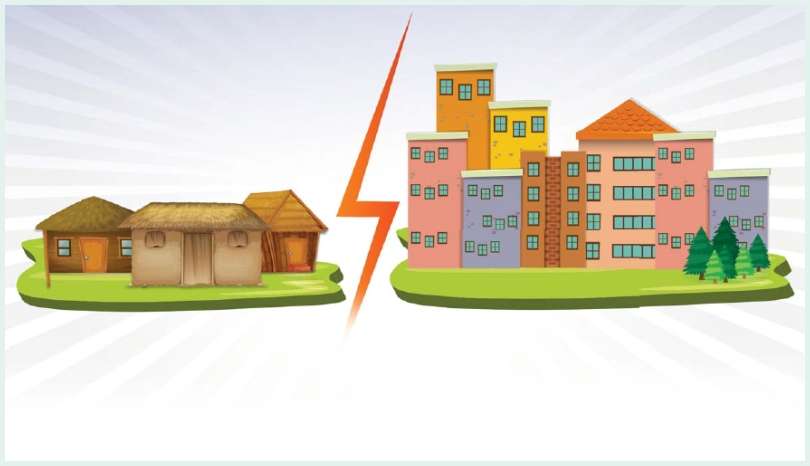Income disparity is a common problem among poor nations. It is imperative for government to launch a special programme o narrow down the gap between rich and poor.
--BY KAMAL RAJ DHUNGEL
Nepali society has long been composed of various castes and ethnicities. Social discrimination across the region, and among and within the caste and ethnic groups including gender is deeply rooted. Persons of lower casts are untouchable. They are not allowed to enter into the houses of upper castes. In one part of Nepal, a girl in her first menstruation should have to live alone over the period of nearly half a month in a cow shed and treated as untouchable for that period. At the time of monthly events, menstruation , irrespective of caste, women are not only able to touch their counterparts but also forbidden to cook food for a certain period of time. Girls, particularly in their tender age have been trafficked traditionally and historically in India and elsewhere now. This phenomenon is common in all the races but more prevalent among the backward ethnic groups of Nepal. In providing education, from the beginning of school age, male and female are discriminated. Boys are sent to private, relatively better schools and and girls to public schools. Moreover, the education system of Nepal produces two kinds of manpower, higher and lower quality. Children of rich families are being admitted to private schools and poor to public schools , thus producing superior and inferior manpower. Along with this, the economic woe is more pronounced. Lesser wages for a woman than her counterpart (man) who is supposed to receive from the same nature of job is still practiced in Nepal.
Income or wealth inequality is skyrocketing. Income refers to households disposable income (income after taxes) in a given year and wealth refers to the abundance of asset possession. The income or wealth inequality is generally measured through the Gini coefficient with value ranges from (0) indicating perfect equality meaning that everyone receives equal share to (1) perfect inequality in which only one recipient or group of recipients receives all the income. The Gini index is used to examine the extent of inequality in the distribution of national income pie. The gini index of less than 0.2, 0.2 to 0.3, 0.3 to 0.4, 0.4 to 0.5 and above 0.5 represent perfect equality, relative inequality, adequate equality, big income gap and severe income gap respectively.
The Gini index of Nepal is 0.40. It indicates high income inequality or big income gap in the distribution of national income indicating a few have access to a major portion of a nation's income pie. For a just distribution of income pie the Gini index should be less than 0.20. Wealth inequality is more terrible in Nepal. The wealth Gini index is 0.67 representing a severe inequality in the distribution of wealth. It reveals that a large portion of wealth is concentrated in the hands of few people. In such a society where the income and wealth gap is comparatively high, few people have access to the larger portion of income and wealth pie while a tiny portion of it has been disbursed over the majority of people.
Poverty is pervasive in Nepal. According to World Bank data 15 percent of the total population, highest among the South Asian countries, is living under absolute poverty having a daily income of less than $1.90 a day, a threshold income line (the minimum level of income deemed adequate in a particular country). The people living under the income level of $1.90 in Bangladesh, India, Pakistan and Sri Lanka is 6.8 percent, 10.6 percent, 4.4 percent and 0.9 percent respectively.
Taking into account the households median income, the amount of income level that divides a population into two equal groups, each group having an amount of income above and below that amount respectively. Presently, the median income of Nepal is $3.20 per day. The poverty rate is 51 percent. It indicates that more than half of the population of Nepal gets income less than median income. However, the median income and poverty rate is more than the income of India and Bangladesh $2.90 per day each, associated poverty rates in India and Bangladesh stood at 60 percent and 59 percent respectively. However, the median income and poverty rate of Nepal is less than Sri Lanka and Pakistan $5.50 and $3.70 per day respectively with a poverty rate 16 percent and 40 percent respectively. It indicates that the poverty rate of Nepal is less than the poverty rate of both the neighbors India and Bangladesh and higher than the Sri Lanka and Pakistan. With respect to poverty rate and associated poverty level Nepal lies in the middle position of its immediately selected four neighbors. In addition to this, 91 percent of the population of Nepal are living on an income level of less than $10 per day.
The unjust distribution of income/wealth and social discrimination among other things has an effect of dividing Nepalese society into several groups, particularly rich and poor, superior and inferior, skilled and unskilled and so on. Socially some people are superior than others, particularly in the upper and lower castes. The policy makers should launch an awareness program to reduce social and racial discrimination and design plans and programs to reduce income and wealth inequality to produce healthy, active and prosperous society.





















